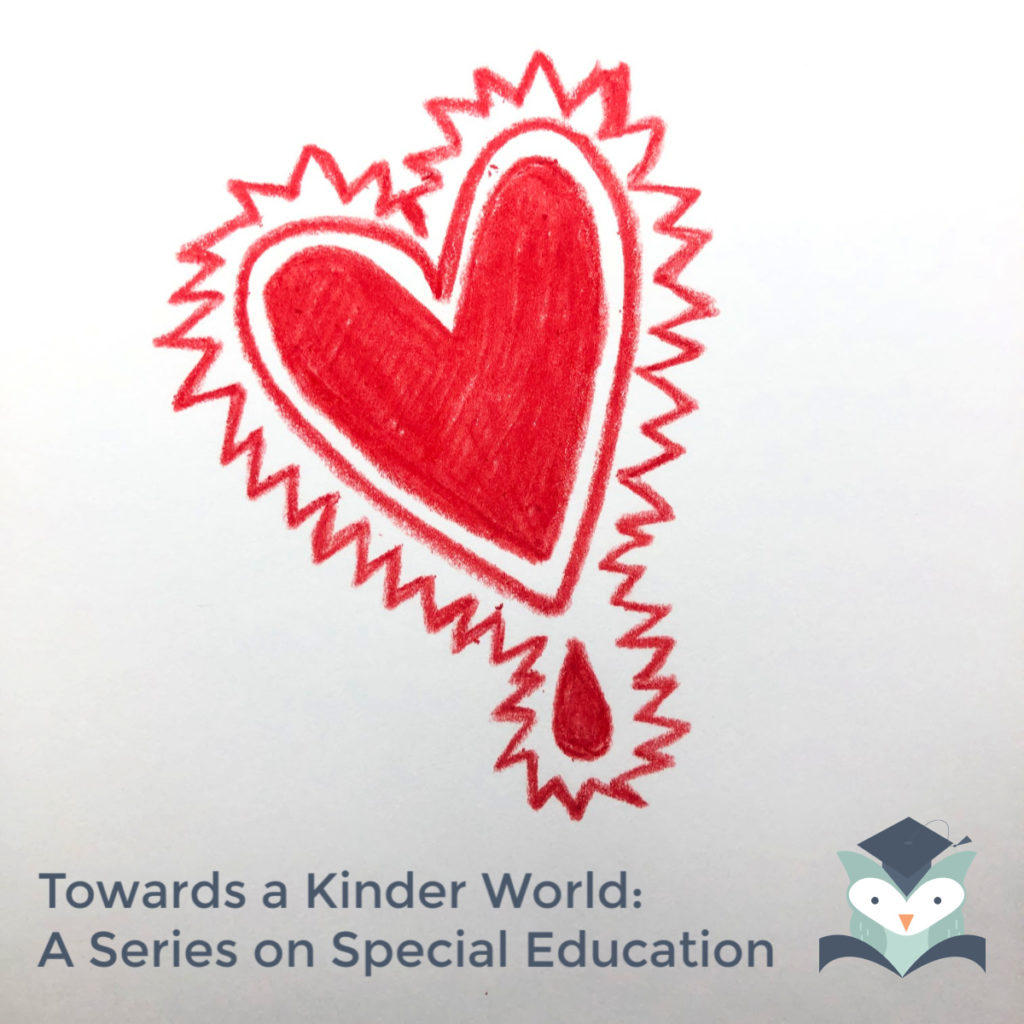
IEP. ARD. LRE. 504. FAPE. PBIS. IDEA. ADA. RTI. ESY. MTSS. SPED.
Somewhere, drowning in alphabet soup, are the vital services your child needs. For the parents of students receiving special education services, some of the acronyms become so familiar they might even forget what the letters stand for.
However, in most cases, there are two acronyms that parents should encounter before any of the others: RTI or MTSS.
Response to Intervention (RTI) and Multi-Tiered System of Support (MTSS) are two strategies that schools should try before recommending a child be evaluated for special education services. Unless the child is coming to school with a previous diagnosis, or the parent is the one pushing for evaluation, RTI and MTSS can prevent a child from an unnecessary label and help him or her stay on track with their peers and avoid the alphabet soup of special education.
Response to Intervention (RTI) describes the three levels of instruction that students should receive before being evaluated for special education services. Multi-Tiered System of Support (MTSS) are similar, but they include social and emotional learning, since behavior can also lead to a special education plan. Districts can choose which of these systems they want to use, and those who use RTI systems often pair them with a social emotional learning strategy, such as positive behavior intervention systems (PBIS . . . another acronym). In the interest of simplicity, this article will focus on MTSS.
What Is MTSS?
The idea behind MTSS is simple: try the simplest things first. If that doesn’t work, move to the next thing.
Most MTSS explanations include a pyramid. At the base of the pyramid is tier one, where the majority of students will learn. This includes engaging, research-based classroom instruction that keeps students focused and moving forward throughout the lesson. Some teachers will need coaching to do this well, but it’s important that they do, because the more students struggle in tier one, the more things get bottlenecked and overburdened in the more intensive level of intervention.
At Gates Elementary School in San Antonio ISD, principal Sonya Mora led a whole-school turnaround centered almost entirely on improving classroom instruction. Even her disciplinary incidents decreased, she said, because kids were just more engaged in what they were supposed to be doing.
On the behavioral side, ordinary classroom social and emotional learning is part of tier one. A growing number of curriculum providers are developing classroom tools for teachers to allow students to identify and manage their feelings. Like academic instruction, some methods get better results than others.
Social and emotional learning advocates say that when used well, group breathework, meditation, calming techniques, and good social and emotional vocabulary can lead to a more “manageable” classroom than what many teachers use as classroom management (the various color and emoji charts used to publicly rate children’s behavior.)
Even in the most engaged classroom, however, some learners are going to need reinforcement. That’s where tier two, small group intervention, is needed. Small group read alouds, reviewing written instructions verbally for several students at a time, having students reteach the lesson to one another. Teachers can get creative, matching students’ needs to the instructional tools they don’t get to use as much. Tier two is also good for kids who are accelerated learners and need a little extra challenge to stay engaged and resist the urge to disrupt class to ease their boredom.
For both academic and social and emotional learning, tier two interventions are usually delivered in a group, though not always, especially for social and emotional learning. Sometimes teachers will keep sensory tools on hand, or involve the school counselor. The interventions are about getting them the tools they need to be able to self-regulate and thrive in the tier one environment.
Tier three is intensive intervention. It looks a lot like the accommodations portion of the IEP. This is where teachers begin to make significant changes to curriculum and instruction, or someone must spend concentrated one-on-one time with students to keep them progressing with the class.
On the academic side, this may include reading tests out loud for struggling readers, allowing more time for certain tasks, or one-on-one concept review.
Social and emotional intervention at tier three may include a behavior contract, special seating to allow for personal space, planned breaks to get up and move, and the involvement of other educators, mentors, and counselors.
Experts say that teachers should expect 75–90 percent of students should be able to learn at tier one. Another 10–25 percent will need the tier two small group reinforcement. Less than ten percent will need the intensive one-on-one interventions in tier three. Even fewer should require a formal IEP with modifications and accommodations to their classroom environment. This does not mean that special education percentages should be lower than the national average. For districts to access the federal and state funding needed for speech therapists, social workers, one-on-one aids, resource classrooms, and the technology needed to support students with physical limitations they do need to go through the assessment process outlined by section 504 of the Rehabilitation Act. However, for students whose IEP only requires classroom accommodations—MTSS interventions could keep those students from unnecessary labels.
So if MTSS is done correctly, fewer students will require an IEP, more students will get support, and every classroom will be a more peaceful place.
We Have MTSS, So Why Isn’t Everything Perfect?
Sounds simple, right?
It’s not, says Dana Wrann. There are several barriers to effective MTSS.
As a special education teacher and MTSS coach, Wrann can see the difference between students who could thrive with classroom interventions and those who need to be pulled out for special education services.
In theory, said Wrann said, time for these interventions should be built into every school day, but she often talks to teachers who aren’t using that time. In addition to general education students missing out on MTSS interventions, those who do receive special education services miss out on instruction if Wrann has to pull them out during math, reading, or another subject. Special education pull outs should be happening during scheduled intervention time, she explained.
In addition to the minutes and hours teachers need to find for intervention, they must also allow weeks and months to determine whether interventions are working.
Each intervention should go on for two to three weeks before a teacher determines that another approach is needed. The goal, Wrann reiterated, is to keep interventions manageable in the classroom. If half the class is on tier three when they could be on tier two, things are going to get backed up.
In some cases, she said, she sees teachers giving students intensive support that should not be permanent in a general education setting. It’s fine to do what needs to be done to keep a kid on pace with content, she explained, but at the same time they should also be receiving interventions to help them gain independence. For instance, if a teacher is reading tests aloud to help a child keep pace in math, science, or history, she said, the student still needs to receive literacy support. If they never learn to read, they will eventually require an IEP to keep their accommodations.
“You can’t just MTSS a kid into special education,” Wrann said.
Teachers also need to take time to document every intervention. Not only do some not feel they have time, Wrann said, but many are not adept at using MTSS software. Wrann is trained on Branching Minds, which San Antonio ISD uses, and says that if entire schools would commit to using the software consistently, the MTSS process would be much smoother. Teachers, parents, coaches, and administrators would know what has been tried, what has worked, and what the agreed upon goals are for the students.
To do that, however, schools must prioritize logging intervention the same way they count attendance and grades.
It’s difficult for educators to figure out what to do next if educators don’t know what has already been tried. Branching Minds allows the notes and interventions to follow students from year to year, like IEP records, and can even follow them to new campuses using the same software. It offers teachers the chance to build valuable resources for the learners if they will simply take the time to track their interventions.
Researchers say some of the biggest challenges to effective MTSS start with tier one. Teachers who are not using research-based curriculum and instruction are likely going to have more students needing interventions, and the system backs up. In higher income schools those teachers may get by because parents will pay for interventions with private tutors, and many have the resources to intervene themselves. In high poverty schools, the classroom can become overwhelmed with unmet needs for support.
MTSS Is Complicated by Trauma, but It’s Also Built for It
Trauma—whether acute or chronic—can also present a hurdle for teachers trying to assess student needs. Acting out, lack of focus, and even habitual “defiance” are all signs that something is wrong. Hunger, fear, lack of sleep, anxiety, sadness, and stress can all look a lot like behavioral and cognitive disabilities.
Instead of trying to diagnose a deficiency with the student, MTSS asks “what does this student need?” and “what is this behavior telling me?”
Trauma and poverty add a lot of variables to the mix, and the structure of MTSS can help keep intervention systematic and organized. Still, the triage process is going to be longer in schools that serve neighborhoods where poverty is concentrated. Adding counselors, wraparound services, mentoring programs, and academic specialists to those campuses can help teachers figure out the most sustainable course of action with the right mix of academic and social interventions, the right balance of interventions.
Questions Every Parent Should Ask About MTSS
Because MTSS benefits the entire classroom, parents don’t have to wait until something is wrong to bring it up with teachers.
Wrann suggested some helpful questions that every parent can ask their child’s teacher to make sure MTSS (or RTI) is being used at school.
- At parent teacher conference, ask if your student is receiving interventions, whether or not the teacher brings it up. Using that language lets teachers know that parents expect MTSS or RTI to be part of the education process.
- If a problem arises, academic or behavioral, always ask, “what have you tried?” This reminds the school that it is their duty to educate the learner. At the same time, it is a collaborative question. It creates a brainstorming session, and rebalances the power in the room.
- If you find out that your child is receiving some kind of intervention, make sure that you have documentation. Ideally the school should notify you in writing that interventions are being used, but sometimes subtle adjustments are not noted. Still, the parent will want documentation that this was an MTSS intervention so that next year’s teacher can start off with successful strategies or avoid things that have not worked in the past.
- If a child is struggling, familiarize yourself with the MTSS or RTI handbook, and asked informed questions about which interventions have been used at each tier. Try things at home and share what works and doesn’t work.
While everyone hopes that MTSS is delivered expertly and equitably, it probably won’t be every time. Parents are critical partners to the process, with unique insight and interest. If they can wade through the alphabet soup of education, they multiply their power with each step.

Charter Moms Chats
Watch Inga Cotton’s interview with Bekah McNeel on Charter Moms Chats.
About the Author
Bekah McNeel is a San Antonio-based education writer who focuses on equity, innovation, and social-emotional learning for publications such as The 74. Over the years, we have republished local education coverage from her Hall Monitor site, and last November she wrote for us a four-part series, “Punished, Not Served,” about unfair discipline for students with disabilities.
Read More
- “Decoding the IEP: Parents Learn From a Special Education Advocate,” Bekah McNeel, San Antonio Charter Moms, April 22, 2020
- “Social Distancing Drives Innovation in Special Education Evaluations,” Bekah McNeel, San Antonio Charter Moms, April 8, 2020
- “Punished, Not Served: Texas Data Shows Students with Certain Disabilities Are More Likely to Be Disciplined than Served,” Bekah McNeel, San Antonio Charter Moms, November 22, 2019
